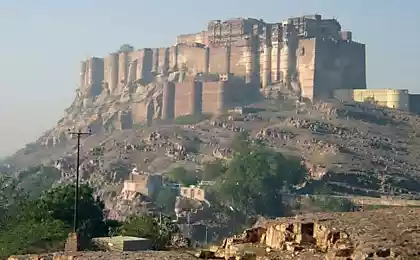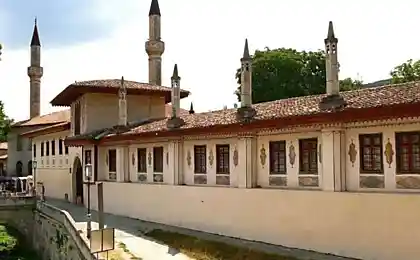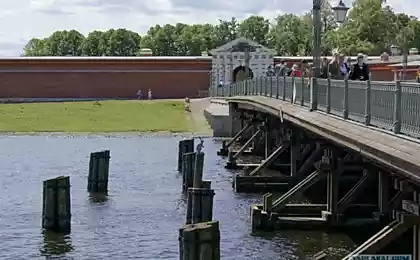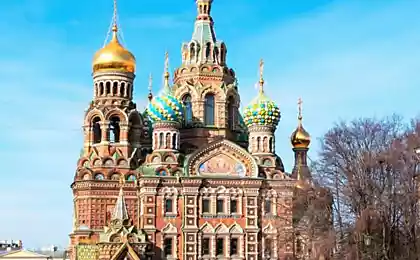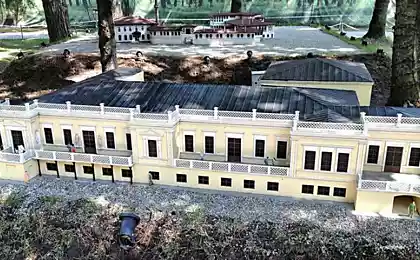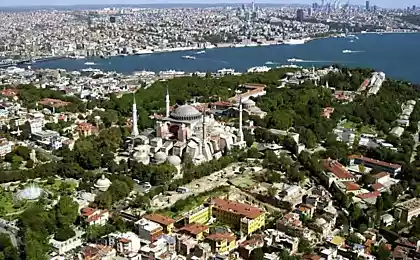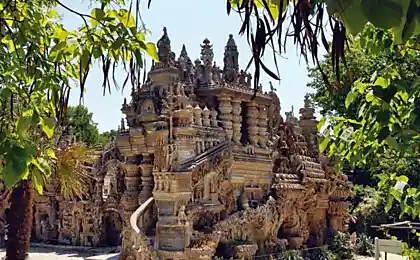1055
The palace, built by the postman (24 pics + text)
French postman Ferdinand Cheval laid the foundation of the Ideal Palace in 1879. He was 43. During the thirty-three years, he worked hard all alone, at night, dragging stones, and in the afternoon continuing to deliver the letter.
Ferdinand Cheval was born in the town with the unpronounceable name Charmes-sur-l'herbasse in 1836. Cheval syzmalstva famous tenacity and stubbornness certain that, along with the removal of dreaminess, has created a truly unique personality. In the end, our hero is moved to a small town (some even call it a village) Hauterive, where he worked as a rural mail carrier.
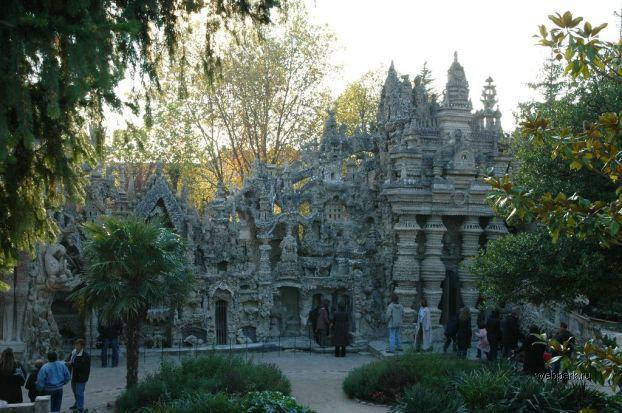
working as a postman, Ferdinand, as a rule, held daily at 32 kilometers, carrying all sorts of letters, packets, complimentary newspapers advertisement and Ikea catalogs. The region, they say, in those days was famous for hot weather, was walking away, and, whether from the irrepressible imagination, or, as they say detractors, away from heat, Cheval began to receive visions of mythical and beautiful palaces.
After all, you never know who of us that sees nothing. But two factors have played a role here - Chevalier persistence and the fact that there the country was in the ancient sea floor. Here and there a lot of nature picturesquely scattered stones.
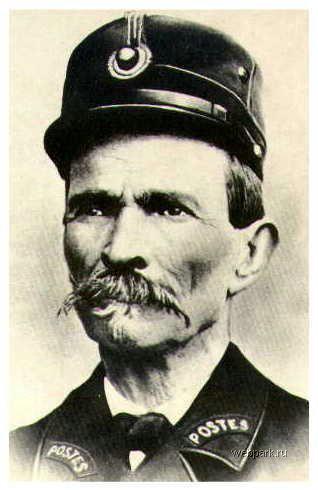
In his notes Cheval admitted that the impetus for the creation of a giant palace served as a strange stone on which he stumbled once in the morning. Layered, flowing rock attracted the eyes, forced to think about other possible forms.
The next day Cheval returned to the same place and picked up a few rock samples. Thus began his 27-year phase of collecting stones. At first, he brought them into his pockets and shawl, then in the basket, and finally began to carry stones on a homemade wheelbarrow, putting them in the backyard. Neighbors thought he was crazy, but he did know, what are the stones.
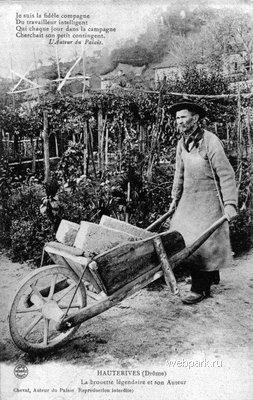
"As nature has given me a building material, I have to be an architect and mason" - decided Cheval. And began bringing home the stones, while studying architecture in different countries and epochs. Like any amateur, he did not have a bias, therefore, it has inspired almost everything - architecture East, Maghreb, Art Nouveau. They say that even Cheval traveled to Algeria. Lie, our knowledge builder learned from the magazine Le Magazin Pittoresque. At the same time he began to study and practical side of things, do not forget to carry the stones on his trusty wheelbarrow.
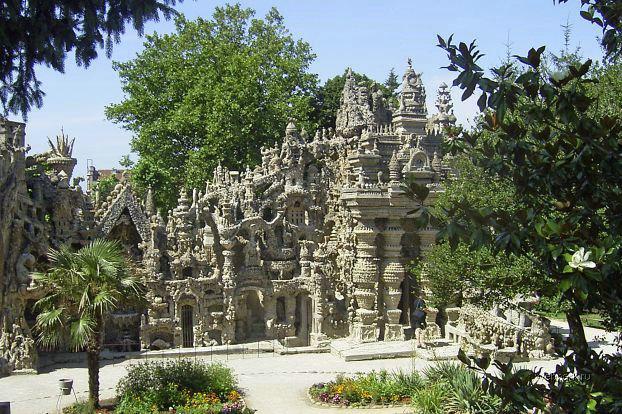
Daily mail route is extended to 10 km at times on a daily basis, but perseverance Chevalier was not to occupy. A total ease our pismonosny each drove stones for 20 years. And since 1888, stepping down to retire, started the construction of the Palace. Ideal Palace - "styles of all countries and times to meet there and mix».
The locals did not immediately realize that they face a genius. Rather, for them it was "an old fool, your garden is flooded with stones." In those blessed times and in the blessed country fashion on Japanese culture is not reached, so the garden with stones representing the villagers and peyzane phenomenon stupid. But, in the end, citizens decided that he, though, and a madman, but not dangerous, and the Chevalier left alone.
And he continued to carry stones and build. 10,000 days, 93,000 hours and 33 years of work - and the first 20 years Cheval worked alone. Palace grew, and even the locals look at this phenomenon in a different way.
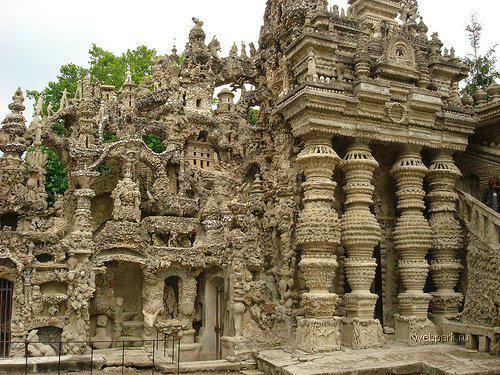
Made of stone, cement and wire Ideal Palace resembled a wild mixture of all styles and locations - the Middle East, China, Algeria, and it was evident the influence of Antonio Gaudi.
However, what to say? We must look.
Black and white photo old palace
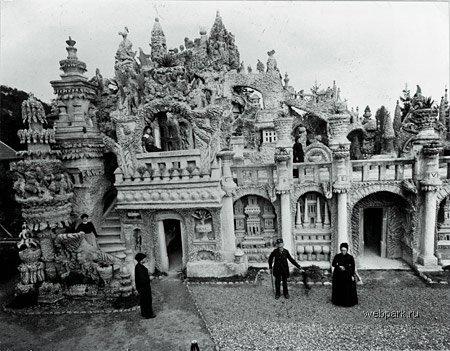
Natural forms are related to the palace: it seems that the Chevalier nothing was impossible, so loose it includes the composition most fantastic details. Furthermore, the overall impression that the author was familiar with, for example, with the Indian temples, so impressive proportions of the columns and sculptures. Although the Ideal Palace like to call first naive architecture itself Cheval never been naive - it just was true to himself and fully dedicated himself to art.
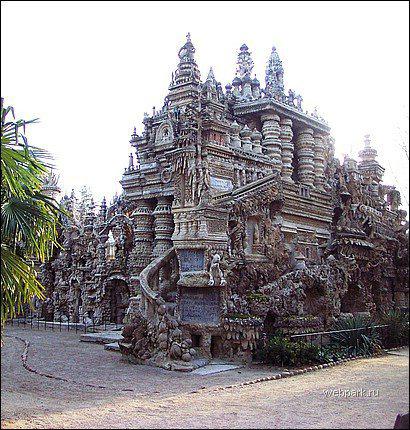
Voobshe Cheval was quite simple Frenchman. At age 13, left school to work in a bakery, but eventually became a mailman. Neither architectural education or skills mason course he did not. But he was a poet. So that the narrow passages of the palace and towers outside covered with his sayings and poems. Here (next to verblyudikom) reads: "By creating this rock, I wanted to establish opportunities will».
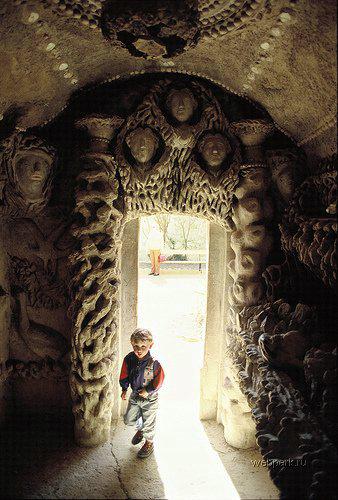
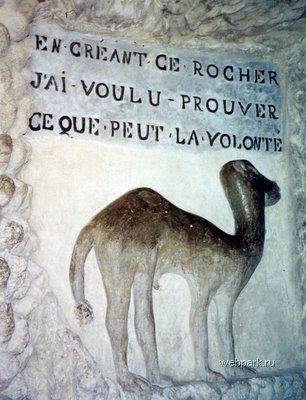
Outside the palace is surrounded by an external staircase adorned with towers and fountains: the viewer look masses sculptures - Egyptian gods, Catholic saints, images of pilgrims and animals. Inside - a long transitions Rakushechnaya mosaics and recessed-sanctuaries. There is a mosque, a church of the Virgin Mary, and so on.
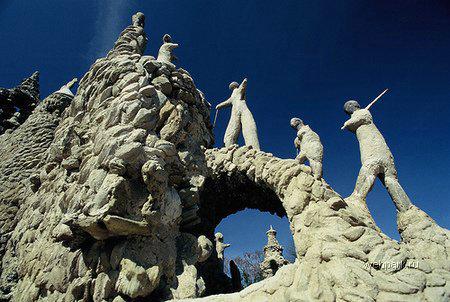
However, the palace is not that big - only 26 to 14 meters in height and 10.
Cheval wanted to be buried in his palace and spent 7 years to build his own mausoleum, where his and laid a year after it was finished: he died in 1924. He was 88 years old.
Under the palace Cheval placed two vault - for himself and his wife. He wanted to be buried under his creation, but do not give him this: whether the government was not allowed, or because the grave "ruin structure bringing him the gloom of death." By the time the Palace has become a local dostoprimechatlnostyu Cheval and willingly showed it, do not forget to sell tickets, however, are very cheap.
The problem was solved with the funeral and just in the spirit of a letter-mad - Cheval bought a plot of land in a cemetery and built there an ossuary.
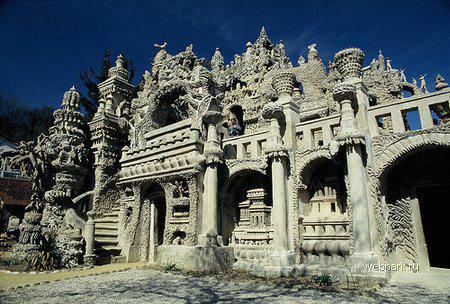
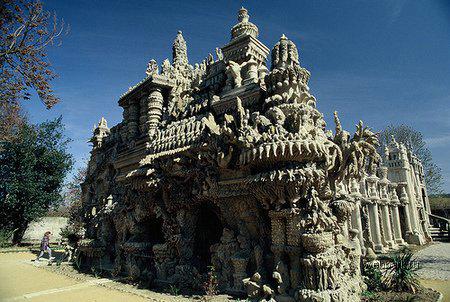
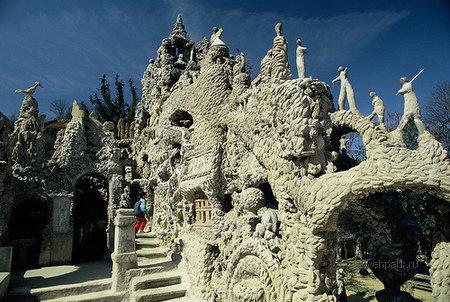
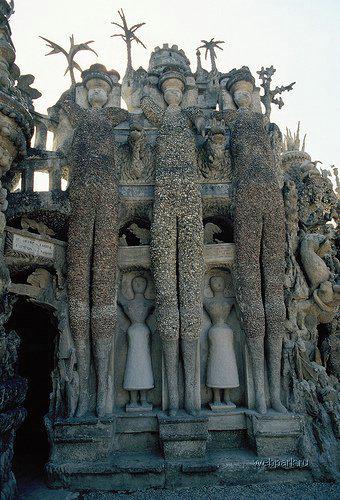
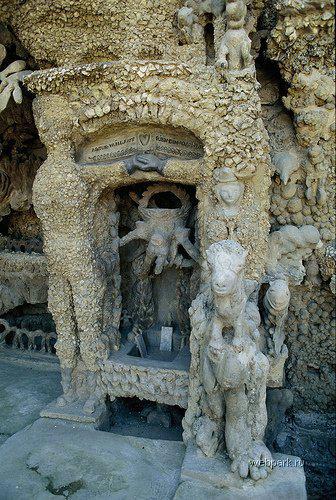
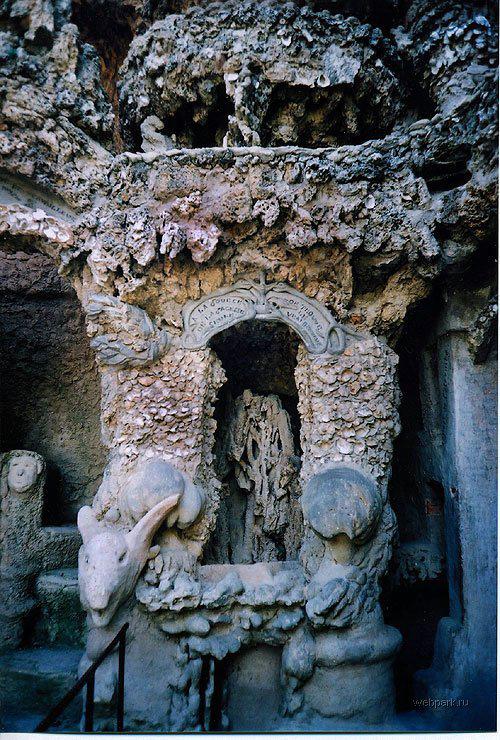
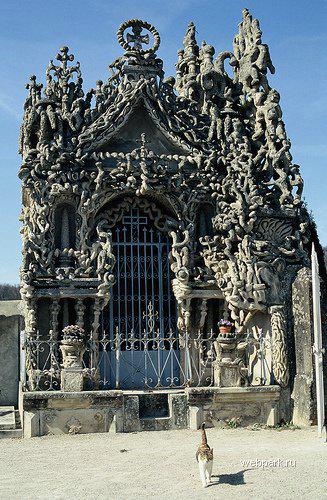
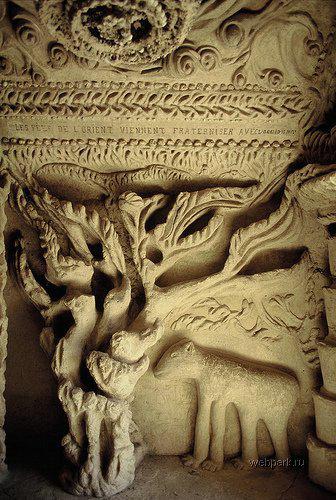
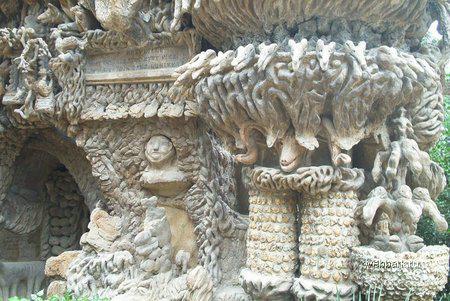
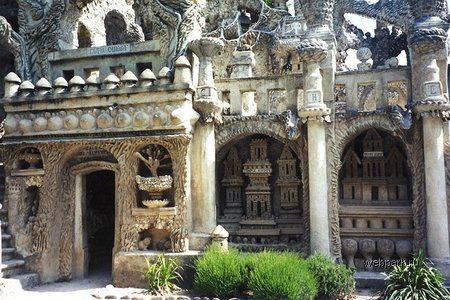
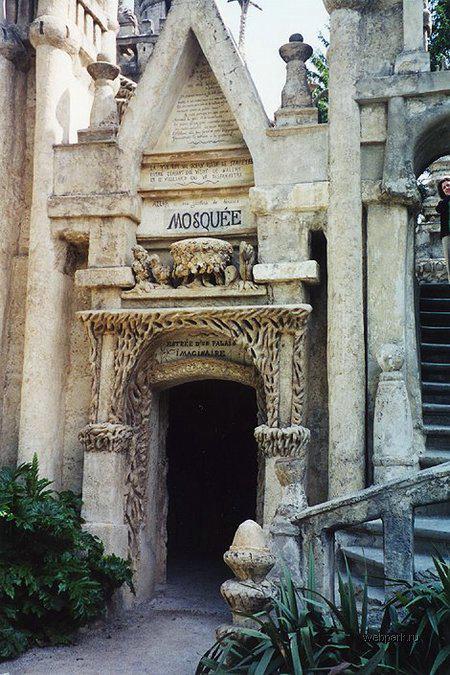
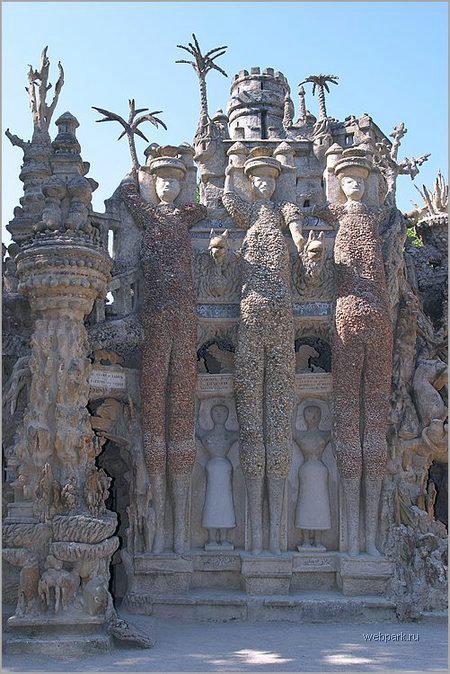
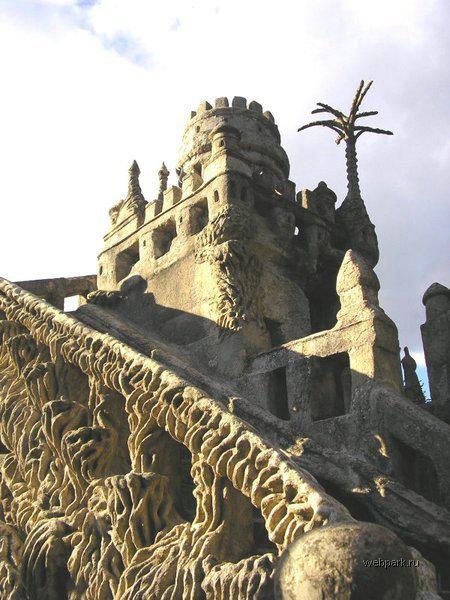
Cheval was very concerned that his palace is not turned into a "local landmark", he wanted to be known as a lot of people. Throughout the life of the mad postman and painstaking writing an autobiography, words from which we conclude:
"No matter what age you are, and what he wanted to achieve, if you are brave enough, persistent and ready for the hard work, you will certainly attain success»
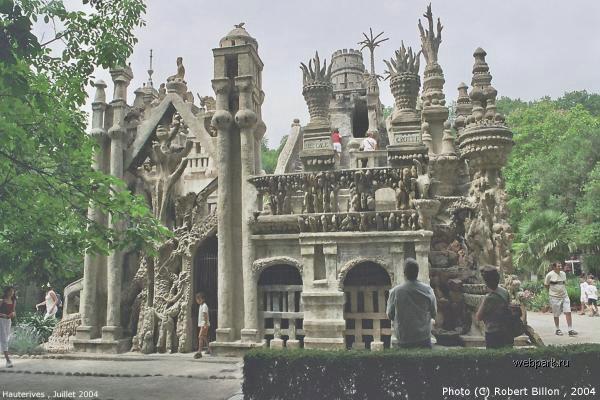
p-i-f
Ferdinand Cheval was born in the town with the unpronounceable name Charmes-sur-l'herbasse in 1836. Cheval syzmalstva famous tenacity and stubbornness certain that, along with the removal of dreaminess, has created a truly unique personality. In the end, our hero is moved to a small town (some even call it a village) Hauterive, where he worked as a rural mail carrier.

working as a postman, Ferdinand, as a rule, held daily at 32 kilometers, carrying all sorts of letters, packets, complimentary newspapers advertisement and Ikea catalogs. The region, they say, in those days was famous for hot weather, was walking away, and, whether from the irrepressible imagination, or, as they say detractors, away from heat, Cheval began to receive visions of mythical and beautiful palaces.
After all, you never know who of us that sees nothing. But two factors have played a role here - Chevalier persistence and the fact that there the country was in the ancient sea floor. Here and there a lot of nature picturesquely scattered stones.

In his notes Cheval admitted that the impetus for the creation of a giant palace served as a strange stone on which he stumbled once in the morning. Layered, flowing rock attracted the eyes, forced to think about other possible forms.
The next day Cheval returned to the same place and picked up a few rock samples. Thus began his 27-year phase of collecting stones. At first, he brought them into his pockets and shawl, then in the basket, and finally began to carry stones on a homemade wheelbarrow, putting them in the backyard. Neighbors thought he was crazy, but he did know, what are the stones.

"As nature has given me a building material, I have to be an architect and mason" - decided Cheval. And began bringing home the stones, while studying architecture in different countries and epochs. Like any amateur, he did not have a bias, therefore, it has inspired almost everything - architecture East, Maghreb, Art Nouveau. They say that even Cheval traveled to Algeria. Lie, our knowledge builder learned from the magazine Le Magazin Pittoresque. At the same time he began to study and practical side of things, do not forget to carry the stones on his trusty wheelbarrow.

Daily mail route is extended to 10 km at times on a daily basis, but perseverance Chevalier was not to occupy. A total ease our pismonosny each drove stones for 20 years. And since 1888, stepping down to retire, started the construction of the Palace. Ideal Palace - "styles of all countries and times to meet there and mix».
The locals did not immediately realize that they face a genius. Rather, for them it was "an old fool, your garden is flooded with stones." In those blessed times and in the blessed country fashion on Japanese culture is not reached, so the garden with stones representing the villagers and peyzane phenomenon stupid. But, in the end, citizens decided that he, though, and a madman, but not dangerous, and the Chevalier left alone.
And he continued to carry stones and build. 10,000 days, 93,000 hours and 33 years of work - and the first 20 years Cheval worked alone. Palace grew, and even the locals look at this phenomenon in a different way.

Made of stone, cement and wire Ideal Palace resembled a wild mixture of all styles and locations - the Middle East, China, Algeria, and it was evident the influence of Antonio Gaudi.
However, what to say? We must look.
Black and white photo old palace

Natural forms are related to the palace: it seems that the Chevalier nothing was impossible, so loose it includes the composition most fantastic details. Furthermore, the overall impression that the author was familiar with, for example, with the Indian temples, so impressive proportions of the columns and sculptures. Although the Ideal Palace like to call first naive architecture itself Cheval never been naive - it just was true to himself and fully dedicated himself to art.

Voobshe Cheval was quite simple Frenchman. At age 13, left school to work in a bakery, but eventually became a mailman. Neither architectural education or skills mason course he did not. But he was a poet. So that the narrow passages of the palace and towers outside covered with his sayings and poems. Here (next to verblyudikom) reads: "By creating this rock, I wanted to establish opportunities will».


Outside the palace is surrounded by an external staircase adorned with towers and fountains: the viewer look masses sculptures - Egyptian gods, Catholic saints, images of pilgrims and animals. Inside - a long transitions Rakushechnaya mosaics and recessed-sanctuaries. There is a mosque, a church of the Virgin Mary, and so on.

However, the palace is not that big - only 26 to 14 meters in height and 10.
Cheval wanted to be buried in his palace and spent 7 years to build his own mausoleum, where his and laid a year after it was finished: he died in 1924. He was 88 years old.
Under the palace Cheval placed two vault - for himself and his wife. He wanted to be buried under his creation, but do not give him this: whether the government was not allowed, or because the grave "ruin structure bringing him the gloom of death." By the time the Palace has become a local dostoprimechatlnostyu Cheval and willingly showed it, do not forget to sell tickets, however, are very cheap.
The problem was solved with the funeral and just in the spirit of a letter-mad - Cheval bought a plot of land in a cemetery and built there an ossuary.













Cheval was very concerned that his palace is not turned into a "local landmark", he wanted to be known as a lot of people. Throughout the life of the mad postman and painstaking writing an autobiography, words from which we conclude:
"No matter what age you are, and what he wanted to achieve, if you are brave enough, persistent and ready for the hard work, you will certainly attain success»

p-i-f




